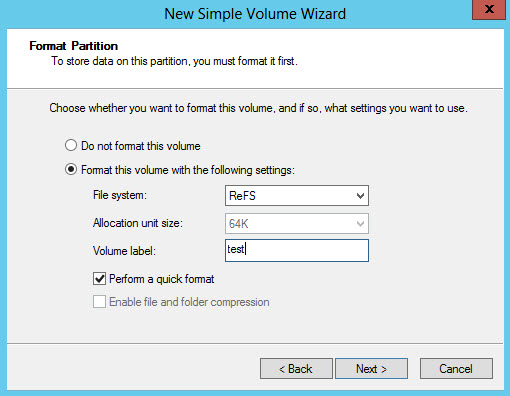ReFS format for disk volumes in Windows Server 2012 and 2012 R2 brings more resiliency than NTFS. Microsoft ReFS and the possibility to use ReFS formatted volumes were introduced early 2012 to provide a filesystem which has more resiliency, and offers auto-healing functions when used together with Storage spaces function.
For those of you not aware of storage spaces, those are basically volumes with disks organized in a JBOD, and presented through the GUI in Win 2012 (or W8.x) to create an aggregate volume of disks. Internal algorithm manages the resiliency, availability and redundancy. The Metadata and file data on ReFS volumes are organized into tables similar to a relational DB.
ReFS formatted volumes used in conjunction with Storage spaces which uses striping and data mirroring. ReFS has built in scanner which is used for auto-healing. This proactively running scanner called scrubber which scans the volume for errors periodically in a background and allows proactively monitor the volume for errors and correct them.
You can't use removable media and format them with ReFS, or USB attached hard drives. ReFS is a local file system and only local disks can be put into the pool.
MSDN quote:
File system metadata is always protected. Optionally, user data can be protected on a per-volume, per-directory, or per-file basis. If corruption occurs, ReFS can detect and, when configured with Storage Spaces, automatically correct the corruption. In the event of a system error, ReFS is designed to recover from that error rapidly, with no loss of user data.
An example of new volume with possibility to be formatted with ReFS:

ReFS based volumes can be performant and resilient depending on the configuration and number of disks participating in the volume. One of the use cases could be scale-out, two-node file server cluster with Storage Spaces, in which the cluster uses a shared JBOD storage configuration with SATA or SAS drives.
Corruption of data can be prevented by ReFS, which can automatically correct corruption on a parity space when integrity streams are enabled to detect corrupt data. It's because ReFS examines the second (and third) copies within the the data parity spaces, and then the correct version is picked up for the correction action.
You can use SSDs and Spinning disk to build a ReFS volume which in Windows Server 2012 R2 can be configured as an auto-tiering solution. Hot data are placed on SSDs where cold data are stored on slower spinning disks.
While it is still version 1.0 of ReFS, I would take maximum precautions before installing at client's sites, starting from the application endpoint (compatibility), continuing through the hardware compatibility list and ending up with lab testing first.
Even though, existing features that were compatible with NTFS like, BitLocker encryption, Access-control lists (ACLs), USN journal, Change notifications, Symbolic links, Mount points or Volume snapshots, are supported.
This does not mean that ReFS is no brainer to be used in any situation, just because it's cool as a technology… Wait and see is always a good strategy. VMware or Microsoft. Your reputation as an IT professional and architect is the first thing you should be concerned.

Does ESXi 6.x support using Microsoft ReFS? For Non shared disk?
I don’t think Server 2016 is supported just yet. We should probably wait until Microsoft gets out the final version first and then wait for VMware support -:|